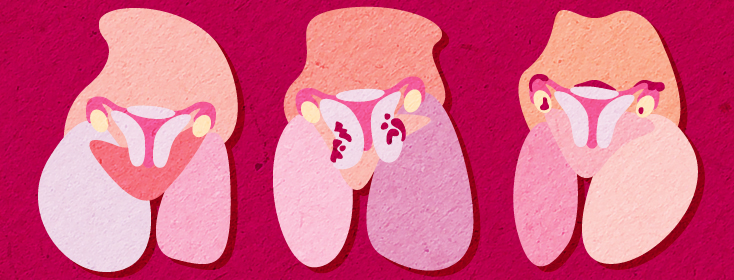Adenomyosis Versus Endometriosis: What Is the Difference?
Adenomyosis and endometriosis are 2 conditions that affect millions of people with a uterus worldwide. It can be easy to confuse the 2 because they both involve growth of endometrial-like tissue outside the uterus. But they are actually quite different conditions.1,2
The main difference is the location of where the tissue grows. Endometrial-like tissue is tissue that is like the lining of your uterus. It can cause problems if it grows outside of the lining of the uterus.1,2
What is adenomyosis?
Adenomyosis is a condition that causes endometrial-like tissue to grow into the muscle wall of the uterus (myometrium). This is different from endometriosis, in which this tissue often grows in the ovaries, fallopian tubes, or other parts of the body.2,3
When this tissue grows into the myometrium, it can lead to changes in the uterus itself. The uterus can thicken and enlarge, growing to up to 3 times the normal size.2,3
Even when it grows outside the uterus, endometrial-like tissue acts as it normally would in the uterus. It thickens and bleeds during the person's menstrual period.2,3
About 1 in 3 people who have adenomyosis do not have any symptoms. For those who do, symptoms may include:1-3
- Enlarged uterus
- A heavy, full, or bloated feeling in your stomach
- Heavy bleeding during your period
- Pain during sex
- Pelvic pain with or without severe cramps
What causes adenomyosis?
The exact cause of adenomyosis is not known. But research suggests certain risk factors for developing this condition. The risk for adenomyosis may be higher in people who:1-3
- Are between the ages of 35 and 50
- Have given birth to more than 1 child
- Have a history of previous surgeries in the uterus
- Have endometriosis
More research is needed to confirm these risk factors. Researchers think there may be a link between endocrine-disrupting chemicals (EDC) and adenomyosis. Research is ongoing in this area.1-3
How is adenomyosis diagnosed?
To diagnose adenomyosis, your doctor will review your symptoms. They also may perform the following tests to look for signs of adenomyosis or rule out other conditions:3
- Pelvic exam – With this exam, your doctor may notice changes in your uterus that can indicate adenomyosis.
- Ultrasound – This type of test uses sound waves to produce images. It can show thickening of your uterus.
- Magnetic resonance imaging (MRI) – This type of test can show whether your uterus is enlarged or thickened.
Are there treatments for adenomyosis?
Several treatment options are available for adenomyosis. Treatments include drugs and surgery. Like endometriosis, the first line of treatment for adenomyosis is usually hormonal drugs. Depending on how mild or severe the symptoms are, people may choose different ways to manage their symptoms.2,3
You may choose to manage your symptoms with nonsurgical options until you reach menopause. Symptoms often improve after menopause because of a decrease in hormones.2,3
For more severe cases, surgical options may need to be explored. Unlike endometriosis, surgery to remove the uterus (hysterectomy) can be used to cure adenomyosis.2,3
Drug and surgical options for treating adenomyosis include:2,3
- Drugs for pain – Nonsteroidal inflammatory drugs (NSAIDs) such as ibuprofen can help with cramps or pelvic pain.
- Hormonal drugs – Options include birth-control pills, birth-control shots, or intrauterine devices (IUDs). IUDs are devices placed in your uterus. Hormonal drugs can help with abnormal bleeding. You will typically need to be on these drugs for at least 3 months to see if they improve cramping and bleeding.
- Surgical procedures – If you have more severe symptoms, a procedure called an adenomyomectomy can remove adenomyosis from the uterine wall. A hysterectomy can also be done to remove your uterus. After the hysterectomy, you will no longer have a menstrual cycle and can no longer get pregnant.

Join the conversation